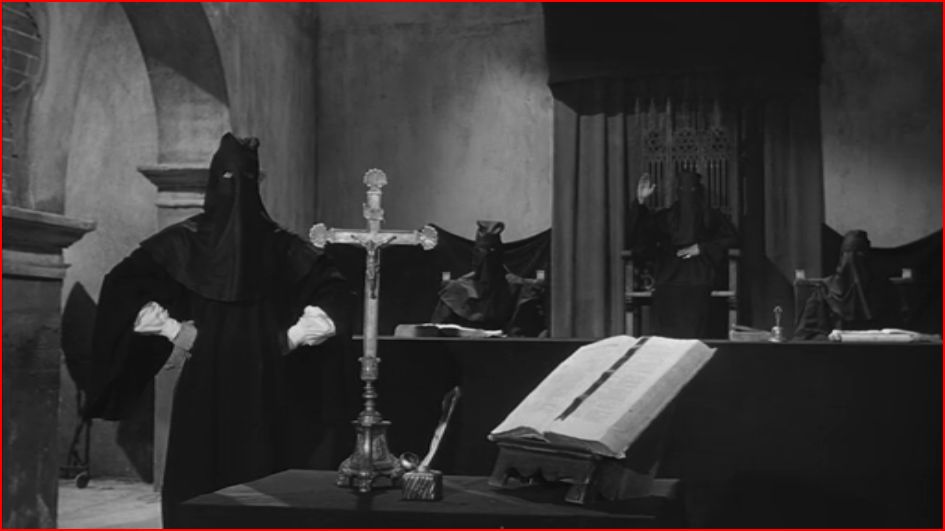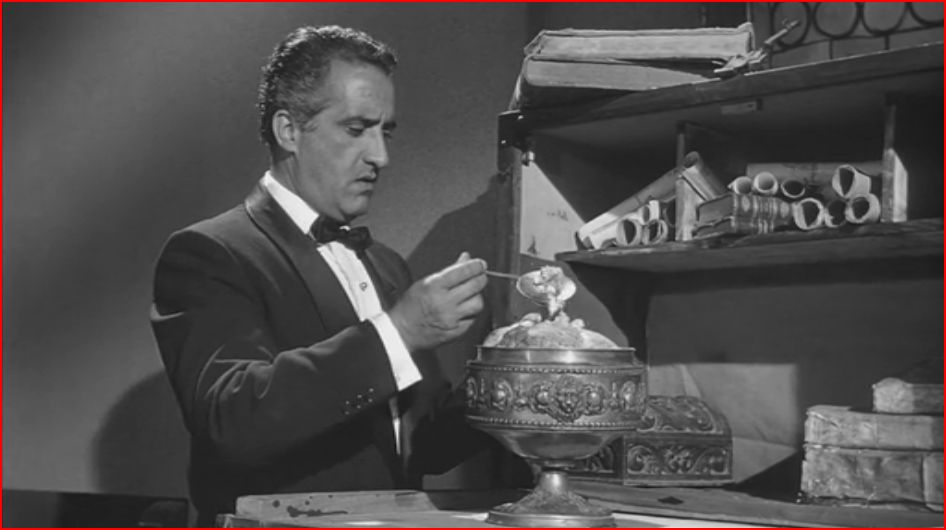


While I hinted above that some lingering guilt about persecutions may underlie this little cycle of vengeance pictures, the overriding truth on screen is that these films' primal victims had it coming. Vitellius d'Estara (Abel Salzar) is definitely some kind of sorcerer. More amused by than fearful of the Inquisition, despite his ultimate submission to burning, the baron shows off his powers by making his shackles disappear as his trial closes. Despite the appeal of one apparent friend, who suffers 300 lashes for his trouble, d'Estara is condemned for the usual litany of offenses against God and man. Focusing on a passing comet as the fire rises, the baron vows to take revenge on the families of his tormentors, whose faces he can see through their black hoods, the next time the comet passes over the Earth.


Three hundred years later, widespread inbreeding makes it easy for the returned d'Estara to identify his targets, if their names hadn't given things away, except when the latest descendants are female. The male descendants are identical apart from the lack of most facial hair. This inbreeding appears to have diminished fertility among the descendants of 17th century inquisitors, since it seems that there's only one descendant of each family (after 300 years!) for the baron to kill. In 1961, two young astronomers in love help their mentor locate a comet passing over their observatory. The girl's a descendant of an inquisitor; the boy descends from d'Estara's only defender. If not star-crossed, they are comet-crossed lovers. A fragment of said comet makes a remarkably soft landing in a park and proves to be a space vehicle with a single passenger. For lack of a better word to describe him, this is the Brainiac. His skull seems to breath as he brandishes his mandibles at a hapless drunk. Despite appearances, his forked tongue has remarkable penetrating power; let him at the base of your skull and he'll suck your brains out. Freshly nourished, he takes on the form of our old friend Vittelius d'Estara, who quickly establishes himself as an old-country aristocrat, complete with faithful lackey, newly settled in the country. Whether his Brainiac form facilitates space travel or is a jape of his master the devil is unclear, but it seems like Vitellius is his default form, though he must eat brains regularly to maintain his humanity. Since his mission of vengeance isn't enough to sustain him, he keeps a goblet of brains, unrefrigerated, in a secret chest, taking a spoonful when necessary in order to keep up appearances at parties.

So much for the interesting part of the film. From this point, which is pretty early, things get monotonous. The baron picks a victim, seduces her if it's a female, intimidates him if it's a male. In human form his eyes flicker with a hypnotic effect that loses some of its force when d'Estara becomes the Brainiac in order to feast. Chase, kill, repeat, until we're down to our two young astronomers. The film might have played up the baron's more ambivalent feelings toward his old friend's descendant, but he doesn't raise the subject until almost the end of the picture. Nor is the young man much of a hero. He's merely a spectator when two cops who've been our comedy relief most of the way show up to save the day, on who knows what hunch, with flamethrowers. We learn here that when you burn a Brainiac there's a human being under all that yuck, but he won't keep in the open air for long.


The baron in his Brainiac form is certainly memorable, if almost laughable in his stylish suits. For all his limitations there's some honest po-faced lunacy about his very existence, and clearly an honest desire to make something original about this latest iteration of an increasingly familiar archetype. El Baron del Terror is no more than an idiot cousin to Bava's classic but there's still something eerie about its mishmash of inquisitions and observatories and its conviction about the persistence of evil in many forms, not just the heritage of the past but the potential of the vastness of space as the domain of the Devil.
1 comment:
Brilliantly written review, Sam! This is one of my all-time favorites of Mexi-horror cinema. I would love to know the history behind this one. There's a commentary on the DVD but I don't recall what all is said on it; so a re-watch is in order! Another absolutely nutty Mexi-horror that doesn't feature wrestlers is SHIP OF MONSTERS.
Post a Comment